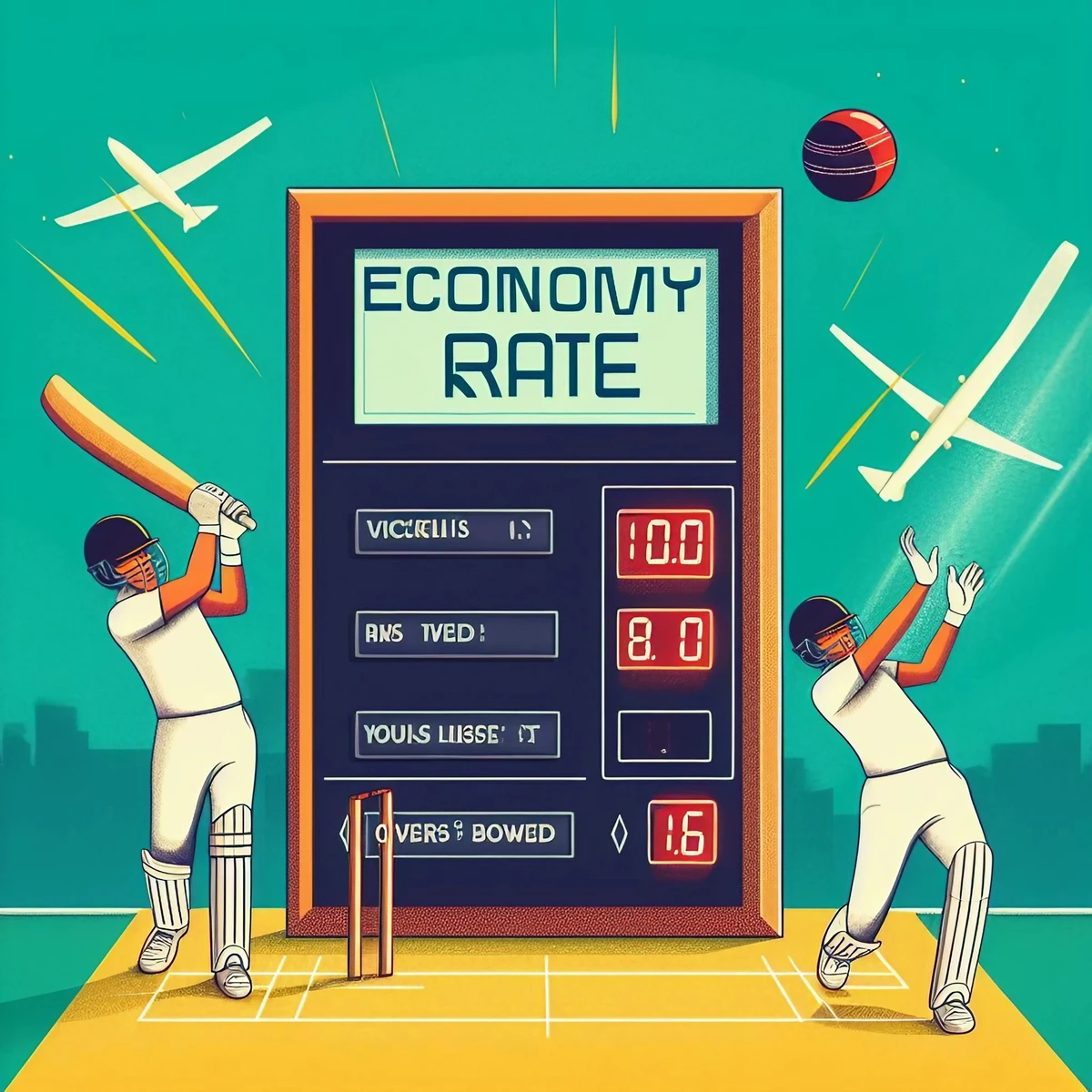Home » Cricket Calculators » Cricket Runs per Over Calculator
Runs per Over Calculator
Cricket Runs per Over Calculator
In the world of cricket, calculating runs per over is crucial for analyzing team performance and individual player contributions.
Claim up to ₹15,000 Welcome Bonus Now
Claim up to ₹15,000 Welcome Bonus Now
- Fastest Indian Rupees Withdrawals
- Fast deposits with UPI
- 450% Bonus up to ₹1,000,000
Runs per over (RPO) measures a team’s run-scoring tempo in limited overs cricket. The RPO calculation divides total runs scored by total overs faced. For example, 240 runs in 40 overs equates to an RPO of 6.
A higher RPO indicates quicker scoring, but factors like powerplays where more runs flow influence it. RPO gives crucial context on setting targets or chasing totals based on typical benchmarks. For players, their batting RPO reveals strike rates.
RPO has applications in planning game strategies too. However, focusing solely on RPO has limitations, since defensive periods also help build an innings.
But overall, analyzing RPO trends provides key insights on batting effectiveness in ODI and T20 matches where scoring quickly matters.
While a simple statistic, mastering the RPO calculation and analysis unlocks a key indicator of batting productivity in limited overs cricket.
What is Runs per Over in Cricket?
Runs per over (RPO) is an important statistic in limited overs cricket formats like ODIs and T20s. It measures the run scoring rate by calculating the average number of runs a batting team is able to score per over.
TL;DR
Hide- The calculation of runs per over in cricket is a valuable tool for analyzing team strategy and player performance. It provides a quantitative measure of a team’s scoring rate and helps us understand their overall performance.
- It’s important to note that the runs per over value can be influenced by various factors, so it should be considered alongside other metrics to get a comprehensive understanding of a team’s performance.
- Runs per over is a useful metric for cricket analysis as it gives insights into a team’s scoring rate and overall performance. By calculating this metric, we can evaluate how effectively a team is scoring runs and adjust their strategy accordingly.
The runs per over is calculated by dividing the total number of runs scored by the total number of overs faced.
For example, if a team scores 300 runs in 50 overs, the runs per over is 300/50 = 6.
A higher runs per over indicates a faster scoring rate. Typical RPO benchmarks:
- ODIs: Between 4-6 is average, over 6 is excellent
- T20s: Over 8 is a competitive score
Runs per over provides crucial context for setting targets, assessing past performances, and gauging a team’s real-time scoring rate relative to the required rate.
It is a key metric for batting effectiveness in ODIs and T20s where scoring quickly is vital.
Importance of Runs per Over Calculation
The calculation of runs per over is of great importance in cricket analytics. By determining the average number of runs scored per over, teams can gain valuable insights into their performance.
This metric, known as the run rate, is a key factor in evaluating batting efficiency and monitoring the progress of a team’s innings.
Data analysis plays a crucial role in predicting run rates. Analysts can examine historical data to identify patterns and trends that influence run rates.
Factors such as pitch conditions, weather, batting order, and the quality of the opposition can all have an impact on the run rate.
Data analysis helps in quantifying the impact of these factors through the use of advanced statistical models. By considering various variables and their relationships, analysts can make accurate predictions about the run rate.
- Net Run Rate Calculator: How to Calculate Run Rate in Cricket
- Cricket Batting Average Calculator
- Cricket Batting Strike Rate Calculator
- Cricket Bowling Average Calculator
- Cricket Bowling Strike Rate Calculator
- Cricket Economy Rate (Econ) Calculator
- Cricket Follow On Calculator
- Cricket Runs per Over Calculator
Moreover, data analysis enables real-time monitoring and adjustment of run rates during a match. Coaches and captains can access live data to make informed decisions based on the current run rate.
This information helps them adapt their strategies, such as promoting aggressive batting or consolidating after a quick fall of wickets.
Basic Formula for Calculating Runs per Over
Calculating the runs per over in cricket involves a simple formula that takes into account the total runs scored and the total number of overs bowled.
This statistic is important for teams as it helps them assess their scoring rate and plan their strategy accordingly.
The formula is as follows:
Runs per Over = Total Runs / Total Overs
By dividing the total runs by the total overs, we can determine the average runs scored in each over. For example, if a team has scored 250 runs in 50 overs, the runs per over would be 5.
It’s worth noting that the accuracy of this calculation can be affected by factors such as variations in scoring rates throughout the innings, rain interruptions, and wickets falling. These factors should be taken into account for a more accurate assessment of the runs per over.
While alternative calculations like weighted averages or different run rate calculations can provide a more nuanced analysis of a team’s scoring rate, the basic formula remains a fundamental tool in understanding runs per over in cricket.
Factors Affecting Runs per Over
There are several important factors that can affect the runs per over in a cricket match.
The condition of the pitch plays a significant role in determining the scoring rate. For instance, a slow and low pitch can make it challenging for batsmen to score quickly, while a flat and fast pitch can lead to a higher run rate.
Another factor that influences the runs per over is the bowling strategy employed by the team. The tactics used by the bowlers can have an impact on both the number of wickets taken and the runs conceded.
Aggressive and attacking tactics may result in more wickets, but they can also lead to more runs being scored by the opposition.
Additionally, the batting order can also play a role in the runs per over. The presence of power hitters at the top of the batting order can contribute to a faster scoring rate.
These batsmen are known for their ability to hit boundaries and score runs quickly, which can boost the team’s run rate.
Pitch Conditions Impact
Understanding pitch conditions is essential for analyzing the factors that impact the runs per over in cricket. The condition of the pitch plays a significant role in determining the run rate during a match.
Different pitch conditions can favor either the batsmen or the bowlers, directly affecting the runs scored per over.
Let’s consider a comparison table to demonstrate the impact of pitch conditions on the run rate:
| Pitch Condition | Runs per Over |
|---|---|
| Flat | High |
| Green | Low |
| Dusty | Medium |
| Spinning | Medium |
As shown in the table, a flat pitch generally results in a higher run rate, while a green pitch favors the bowlers and leads to a lower run rate.
Dusty and spinning pitches tend to have a medium run rate. Understanding these pitch conditions is crucial for teams to strategize their run rate analysis and adapt their batting approach accordingly. Now, let’s explore how bowling strategy affects the runs per over.
Bowling Strategy Affects
The bowling strategy of a team directly impacts the number of runs scored per over in cricket. Analyzing the strategy and evaluating the scoring rate helps teams determine the most effective approach to restrict the opposition’s scoring.
Several factors influence the runs per over in relation to bowling strategy analysis and scoring rate evaluation:
- Field placement: The positioning of fielders can create pressure on the batsman, making it challenging for them to score freely.
- Line and length: Consistently bowling in the right areas can limit the batsman’s scoring options and induce mistakes.
- Variation of pace: Introducing slower balls or cutters can deceive the batsman and result in wickets or dot balls.
- Use of spinners: Deploying spinners in suitable situations can exploit pitch conditions and make scoring difficult for the opposition.
- Tactical changes: Adapting the bowling strategy based on the batsman’s strengths and weaknesses can aid in containing runs and taking wickets.
Batting Order Influences
Factors that influence the scoring rate in cricket can be attributed to the batting order. The order in which batsmen come to the crease can have a significant impact on the runs per over. Analyzing and optimizing the batting order is an important aspect of strategic planning in cricket.
Coaches and captains carefully consider various factors when deciding the batting order, including the strengths and weaknesses of individual batsmen, the match situation, and the pitch conditions.
Placing aggressive and big-hitting batsmen at the top of the order allows teams to score quickly and set a high run rate from the start.
On the other hand, sending in more defensive-minded batsmen lower down the order can help stabilize the innings and maintain a steady run rate. For example, in Table 1, we can see the runs per over achieved by each batsman in a specific batting order.
Analyzing the batting order helps teams identify any inefficiencies or areas for improvement. By strategically arranging the batsmen based on this analysis, teams can maximize their run-scoring potential.
Making informed decisions about the batting order can lead to a higher runs per over and ultimately improve the team’s chances of winning matches.
Interpreting Runs per Over Values
To grasp the importance of runs per over values in cricket, it’s crucial to consider their context and implications for the game.
Interpreting runs per over values allows for a deeper analysis of a team’s batting performance and provides valuable insights into their overall strategy.
Here are some practical applications of runs per over (RPO) in cricket analysis:
- Assessing batting aggression: RPO values indicate the scoring rate of a team, reflecting their approach to batting. Higher RPO values suggest an aggressive batting style, aiming to score quickly, while lower values indicate a more cautious approach.
- Comparing batting performances: By comparing RPO values across different matches or teams, analysts can evaluate the effectiveness of various batting line-ups and strategies. This helps identify patterns and trends in team performance.
- Evaluating bowling efficiency: RPO values also provide insights into the effectiveness of the bowling team. Lower RPO values suggest tight bowling, making it difficult for the batting team to score freely, while higher values indicate a lack of bowling control.
- Predicting match outcomes: RPO values can be used to predict the final score and potential match results. By analyzing RPO values and comparing them to historical data, analysts can make informed predictions about the outcome of a match.
- Identifying strengths and weaknesses: By assessing RPO values, teams can pinpoint areas of improvement, such as slow scoring rates or ineffective bowling. This allows them to strategize and adapt their game plan accordingly.
Use of Runs per Over in Team Strategy
Analyzing the runs per over data can provide valuable insights for team strategy in cricket. By examining the strategic run rate analysis, teams can identify the required run rate and plan their innings accordingly.
Additionally, the runs per over can impact the batting order, with teams adjusting their lineup based on the required run rate and the batsmen’s ability to score quickly.
Moreover, the runs per over can influence bowling tactics, with teams adapting their approach to either restrict the opposition’s scoring or take wickets more aggressively.
This data-driven analysis is essential for teams to make informed decisions and maximize their chances of success on the field.
Strategic Run Rate Analysis
The analysis of runs per over in cricket is a strategic tool that helps teams assess and enhance their performance.
By examining the scoring rate, teams can identify areas for improvement and develop effective strategies against specific opponents.
Monitoring runs per over throughout a match guides decision-making, such as when to increase the scoring rate or consolidate innings. Comparing runs per over with the opposition provides insights into relative strengths and weaknesses.
Evaluating runs per over in different phases of the game informs tactical adjustments. Understanding and utilizing runs per over strategically can have a significant impact on a team’s performance.
In the next section, we will explore how runs per over influences a team’s batting order.
Impact on Batting Order
The analysis of runs per over in cricket has a significant impact on a team’s batting order and overall strategy. By examining the runs per over data, teams can make informed decisions about the sequence in which batsmen come to the crease.
This analysis takes into account various factors such as the required run rate, the type of pitch, the strength of the opposition’s bowling attack, and the current game situation.
Instead of simply stating the importance, batting order analysis helps teams determine whether to send aggressive hitters or more defensive players to the crease.
For instance, if the required run rate is high, teams may promote power hitters up the order to quickly score runs. On the other hand, in a steady run chase, teams may opt for middle-order batsmen with a reliable defensive technique.
Adjusting Bowling Tactics
Teams in cricket can use runs per over data to adjust their bowling tactics and incorporate them into their overall team strategy.
By analyzing the runs per over conceded by bowlers, teams can identify areas for improvement and make necessary adjustments.
Here are some ways teams can use runs per over data in their bowling tactics:
- Identify bowlers with high economy rates and work on their bowling variations to reduce the number of runs conceded.
- Implement defensive fielding strategies for bowlers who consistently give away a high number of runs per over.
- Use runs per over data to determine the ideal bowling order, ensuring the most economical bowlers are used during crucial stages of the game.
- Analyze the runs per over against different batting line-ups to develop specific plans for different opponents.
- Incorporate runs per over data into team meetings and discussions to formulate effective bowling strategies.
Comparison of Runs per Over Across Teams
When comparing the runs per over in cricket across different teams, it’s important to analyze their performances.
By comparing the runs per over between teams, we can understand how effective their batting and bowling strategies are.
This analysis provides valuable insights into team performance and their ability to score runs or restrict opponents.
Teams that consistently score at a high rate have strong batting line-ups and play aggressively. On the other hand, teams with a low runs per over may struggle to score quickly and need to improve their batting approach.
Additionally, analyzing the runs per over can help identify teams with effective bowling strategies. Teams with a low runs per over against them may have bowlers who excel at restricting the opposition.
It’s important to note that runs per over alone cannot determine match outcomes. Other factors like wickets taken and target set also play a crucial role.
However, runs per over provides a valuable statistical measure to compare team performances and identify areas of improvement.
Moving on to the next section about ‘runs per over and player performance,’ let’s explore how individual players contribute to the team’s runs per over and their impact on match outcomes.
Runs per Over and Player Performance
Analyzing how individual players contribute to the runs per over can provide valuable insights into their performance and impact on team success.
By examining the runs scored by each player in relation to the number of overs they faced, we can assess their efficiency and effectiveness in scoring runs.
This analysis is crucial for evaluating a player’s performance and understanding their role within the team strategy.
Here are five important points to consider when evaluating player performance in terms of runs per over:
- Consistency: A player who consistently scores runs at a high rate per over demonstrates their ability to maintain a steady flow of runs throughout their innings.
- Strike rate: The strike rate indicates the number of runs scored by a player per 100 deliveries faced. A higher strike rate implies a more aggressive and impactful player.
- Partnership building: Examining how players contribute to partnerships can highlight their ability to build crucial stands with their teammates, leading to higher runs per over.
- Match-winning contributions: It is important to identify players who consistently make significant contributions to the team’s success by scoring runs at crucial moments during the match.
- Adaptability: Players who can adjust their gameplay according to the match situation and team strategy are likely to have a positive impact on the team’s runs per over.
Considering these factors allows teams to make informed decisions about player selection, batting order, and strategies that optimize the team’s runs per over and overall performance.
Historical Trends in Runs per Over
Analyzing the historical trends in runs per over provides valuable insights into the evolution and effectiveness of scoring rates in cricket.
By examining the data from previous matches and tournaments, we can identify patterns and understand the impact of various factors on batting performance.
To illustrate these trends, let’s take a look at the following table:
| Year | Average Runs per Over |
|---|---|
| 2010 | 4.83 |
| 2012 | 5.07 |
| 2014 | 5.32 |
| 2016 | 5.58 |
| 2018 | 5.75 |
From this table, we can observe a steady increase in the average runs per over over the years. This indicates a shift towards more aggressive batting strategies and the evolution of power-hitting in the game.
The increasing trend also suggests that teams have become more proficient in scoring quickly and setting higher run targets.
These historical trends have had a significant impact on the batting order. To take advantage of the increasing scoring rates, teams often prioritize power-hitters and aggressive batsmen in their lineups.
This shift in the batting order has led to a more dynamic and explosive style of play, with batsmen aiming to score at a faster rate from the start of the innings.
Limitations of Runs per Over Calculation
When calculating runs per over in cricket, there are several factors that need to be considered. One important factor is the variability of the run rate between innings.
Teams often employ different strategies based on the match situation, which can lead to fluctuations in the scoring rate.
Another factor to consider is the impact of the batting order on the run rate. The performance of top-order batsmen is typically different from that of lower-order batsmen, which can affect the scoring rate.
Additionally, the pitch and weather conditions play a significant role in the scoring rate. Slower pitches and adverse weather conditions can make it more challenging for batsmen to score quickly.
Taking these factors into account is crucial when calculating runs per over in cricket. It provides a more comprehensive understanding of the game and allows for a fair assessment of team performance.
Innings-Specific Run Rates
The concept of innings-specific run rates provides valuable insights into the limitations of using runs per over as a sole metric to evaluate batting performance in cricket.
While runs per over is commonly used, it fails to capture the nuances that occur within individual innings.
Let’s take a closer look at some of the limitations of relying solely on runs per over:
- Strategic Decision-making: Runs per over calculation overlooks the strategic decisions made by batsmen and the entire team during an innings. It fails to consider the importance of consolidating or accelerating the run rate based on the specific match situation.
- Historical Context: Runs per over calculation does not take into account historical trends and patterns. It fails to acknowledge the impact of pitch conditions, weather, and the quality of the opposing team on the overall batting performance.
- Variation within an Innings: Runs per over calculation treats all overs within an innings equally, disregarding the variation in scoring rates that can occur throughout the course of the innings.
- Contextual Factors: Runs per over calculation does not consider important contextual factors, such as the target set by the opposition, the required run rate, or the number of wickets in hand. These factors can significantly impact the approach and strategy of the batting team.
- Individual Contributions: Runs per over calculation does not provide insights into individual contributions within an innings. It fails to acknowledge the importance of partnerships, individual milestones, and match-winning performances that can greatly influence the outcome of the game.
Impact of Batting Order
Understanding the limitations of calculating runs per over in cricket requires us to examine the impact of the batting order. The batting order plays a crucial role in determining the team’s run rate.
Each player has their own abilities and roles within the team, and their performance can significantly affect the overall run rate.
Analyzing player performance is essential in understanding how the batting order influences runs per over. By studying the batting order, we can identify the players who excel in accelerating the scoring rate and those who may struggle in certain positions.
This analysis allows teams to make strategic decisions regarding player placement and optimize their run rate.
However, it’s important to note that other factors like pitch and weather conditions can also impact the calculation of runs per over.
Pitch and Weather Conditions
Pitch and weather conditions have a significant impact on the calculation of runs per over in cricket. These factors can greatly influence gameplay and affect the scoring rate.
Here are some important factors to consider:
- The impact of pitch conditions: The nature of the pitch, including its hardness, dryness, or grass cover, can affect the bounce, pace, and turn of the ball. For instance, a slow and low pitch can make it challenging for batsmen to score quickly, while a fast and bouncy pitch can lead to higher scoring rates.
- The effect of weather on gameplay: Weather conditions like rain, wind, and humidity can impact the movement of the ball in the air and off the pitch. Rain interruptions can reduce the number of overs, resulting in changes to the target calculation. Windy conditions can make it harder for bowlers to control the ball, affecting their accuracy, as well as the ability of batsmen to time their shots.
Understanding these limitations is crucial when analyzing the runs per over in cricket, as they play a significant role in determining the overall scoring rate and the strategies employed by teams.
Practical Applications of Runs per Over in Cricket Analysis
The practical applications of runs per over in cricket analysis can be observed through evaluating team performance and individual player contributions.
By analyzing the runs per over, cricket analysts and coaches can assess the effectiveness of a team’s batting or bowling performance during a match or series of matches.
This statistical analysis helps identify the scoring rate of a team and reveals trends or patterns in their batting or bowling performance.
This information is valuable for evaluating overall team performance and identifying areas for improvement.
Additionally, runs per over can be used to evaluate the contributions of individual players. By analyzing the runs per over scored or conceded by each player, analysts can determine the impact of a player’s performance on the team’s scoring rate or run rate.
This analysis assists coaches and selectors in making informed decisions about team selection and player performance.
Furthermore, runs per over can be used to compare the performance of different teams or players. By comparing the runs per over of different teams or players, analysts can identify the strengths and weaknesses of each and make strategic decisions accordingly.
This analysis is particularly useful in preparing for upcoming matches or series as it allows teams to identify areas that require focus in order to improve their overall performance.
Conclusion
The runs per over calculation in cricket is a valuable tool for analyzing team strategy and player performance. It provides a quantitative measure of a team’s scoring rate and helps understand their overall performance.
However, it’s important to consider other factors that may affect the runs per over value and be aware of the limitations of this calculation.
Runs per over is a useful metric for cricket analysis, providing insights into a team’s performance and scoring rate.
Frequently Asked Questions
How do you calculate runs per over in cricket?
Runs per over is calculated by dividing the total number of runs scored by the total number of overs faced by the batting team.
For example, if a team scores 240 runs in 40 overs, the RPO is 240/40 = 6.
How many runs are there in an over in cricket?
An over in cricket consists of 6 legal deliveries bowled by the bowler. The batting team aims to score off each ball, so the runs scored per over can vary anywhere from 0 up to 36 runs if all balls are hit for sixes.
How many runs per over is good?
In ODIs, an RPO of 5-6 is considered good. In T20s, an RPO of 8 or more is a competitive score.
Get up to ₹20,000 Bonus Every Week!
Get up to ₹20,000 Bonus Every Week!
- Easy Sign-Up and Deposits
- Fast deposits with UPI
- 300% Welcome Bonus up to ₹10,000
How many balls are in 1 over?
There are always 6 legitimate balls delivered in a single over in cricket. An over must have 6 complete legal deliveries bowled, unless shortened by wickets falling.
Other Cricket Calculators
Latest Cricket Posts
Claim 200% Welcome Bonus
For a limited time, every new member can claim 200% Welcome Bonus upon registration up to ₹15,000. Read to bet?














